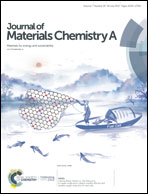Flexible solvent-free supercapacitors with high energy density enabled by electrical-ionic hybrid polymer nanocomposites†
Abstract
High-performance flexible solvent-free supercapacitors are promising for next-generation energy storage with excellent reliability, high energy density, and improved safety. However, the low ionic conductivities of solvent-free polymer solid electrolytes (PSEs) and poor electrolyte/electrode contacts impede their applications. Here, we report a PVDF-HFP/LiBOB PSE and novel electrical-ionic hybrid polymer nanocomposite (EIHPN) electrode to address these challenges. With the large-sized BOB− acting as a solid plasticizer, the PVDF-HFP/LiBOB PSE shows a high ion conductivity up to 6.1 × 10−5 S cm−1 at 25 °C and 5.7 × 10−4 S cm−1 at 80 °C. This PSE is adopted as both the host of graphene oxide/carbon nanotube scaffold to form GO/CNT/PSE nanocomposite electrodes and separator to form flexible solvent-free lithium-ion symmetric supercapacitors. The EIHPN electrodes facilitate the access of ions to capacitive material surfaces and their monolithic integration with PSE remarkably improves the electrode/electrolyte contacts, leading to a high double-layer specific capacitance of 267 F g−1 at 1 A g−1, comparable to the records of carbon electrodes in liquid electrolytes. The EIHPN structure also enables a nearly thickness-independent performance and an ultrahigh areal capacitance of 590 mF cm−2 at 1 mA cm−2 has been achieved with 100 μm-thick electrodes. The supercapacitors show a low self-discharge characteristic, an ultrahigh specific energy of 30 W h kg−1 at 1 A g−1 and a high energy density of 6.64 mW h cm−3 at 1 mA cm−2 and excellent cyclic reliability (over 88% capacitance retention after 20 000 charge–discharge cycles) and flexibility (negligible capacitance decay after 10 000 bending tests), demonstrating great potential for flexible energy storage.



 Please wait while we load your content...
Please wait while we load your content...